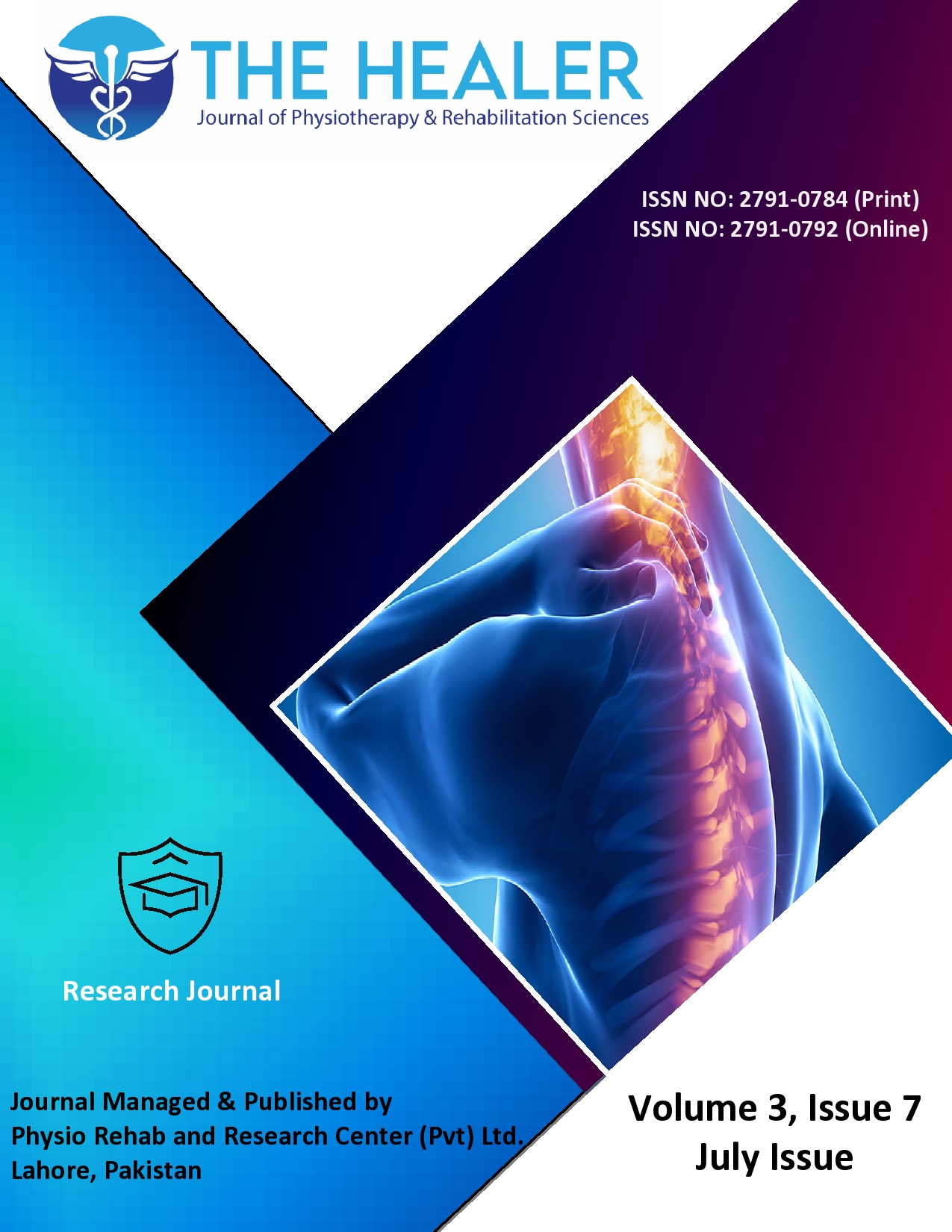Effects of Trunk Strengthening Exercises on Static Sitting Balance in Children with Quadriplegic Cerebral Palsy
Trunk Strengthening Exercises in Quadriplegic Cerebral Palsy
DOI:
https://doi.org/10.55735/hjprs.v3i7.188Keywords:
balance, quadriplegic cerebral palsy, sitting balance, strengthening exercises, trunk controlAbstract
Background: Cerebral palsy is a neurological disorder that is caused by non-progressive damage to the brain or malformation which occurs in an underdeveloped child’s brain and is considered among the most common etiology of severe disability in children. Trunk control measure was used to assess sitting balance and it was seen that universal exercise system brings a significant improvement in sitting balance of these athetoid types of children. Objective: To determine the effects of trunk strengthening exercises on static sitting balance in children with quadriplegic cerebral palsy. Methods: This quasi-experimental study was conducted at the outpatient Department of Physical Therapy, THQ Hospital Jampur. Forty patients diagnosed with quadriplegic cerebral palsy were selected using predefined inclusion and exclusion criteria. Data was collected using a trunk control measurement scale. Outcomes were recorded at the start and the end of treatment at 6 weeks in terms of gross motor function and structural deformity as recorded on the gross motor function classification scale and scoliosis status respectively. The descriptive statistics used to analyze data were presented as frequency tables. While the age and score of the trunk control measure were analyzed for its mean and standard deviation along with a graphical presentation in the form of a histogram. The tests of normality were employed for outcome variables and it was found to be non-parametric. Wilcoxon signed-rank test was used to compare the means of these non-parametric-based variables to a difference before and after treatment. Results: At the end of the sixth week, the mean and standard deviation for the trunk control measurement scale before and after were 12.33±1.82 and 15.64±2.01, respectively while those of skewness/ kurtosis values were -0.30/-0.23 and 0.26/1.22. The results of the comparison of means using the Wilcoxon signed-rank test showed that trunk control after treatment improved significantly as compared to that of before treatment (0.000), with a majority greater ranks of 16.39, while negative ranks were found to be 3.00 on average. Conclusion: The findings of the study concluded that trunk strengthening exercises significantly improved static sitting balance in children with quadriplegic cerebral palsy.
References
Abrisham SMJ, Kermani-Alghoraishi M, Ghahramani R, Jabbari L, Jomeh H, Zare M. Additive effects of low-level laser therapy with exercise on subacromial syndrome: a randomised, double-blind, controlled trial. Clinical rheumatology 2011; 30(10): 1341-6.
Lundkvist Josenby A, Czuba T, Alriksson-Schmidt AI. Gender differences in treatments and interventions received by children and adolescents with cerebral palsy. BMC pediatrics 2020; 20(1): 1-9.
Masood F, Khan MSG, Afzal F, Rashid A, Mubarak S. Effects of Spider Cage Therapy in Combination with Conventional Speech Therapy on Speech and Language Function in Children with Cerebral Palsy of Age between 05 and 15 Years.
Ross SM, MacDonald M, Bigouette JP. Effects of strength training on mobility in adults with cerebral palsy: A systematic review. Disability and health journal 2016; 9(3): 375-84.
Adıguzel H, Elbasan B. Effects of modified pilates on trunk, postural control, gait and balance in children with cerebral palsy: a single-blinded randomized controlled study. Acta Neurologica Belgica 2022: 1-12.
Unger M, Jelsma J, Stark C. Effect of a trunk-targeted intervention using vibration on posture and gait in children with spastic type cerebral palsy: a randomized control trial. Developmental neurorehabilitation 2013; 16(2): 79-88.
Degerstedt F, Wiklund M, Enberg B. Physiotherapeutic interventions and physical activity for children in Northern Sweden with cerebral palsy: a register study from equity and gender perspectives. Global Health Action 2017; 10(sup2): 1272236.
Odhiambo JA, Omoke CM, Aloka PJ. Gender differences in response to motor skill training on the performance of dressing as an activity of daily living by pupils with cerebral palsy in Kisumu, Kenya. 2016.
Mehraban AH, Hasani M, Amini M. The comparison of participation in school-aged cerebral palsy children and normal peers: A preliminary study. Iranian journal of pediatrics 2016; 26(3).
Hägglund G, Czuba T, Alriksson‐Schmidt AI. Back pain is more frequent in girls and in children with scoliosis in the context of cerebral palsy. Acta Paediatrica 2019; 108(12): 2229-34.
Cloake T, Gardner A. The management of scoliosis in children with cerebral palsy: a review. Journal of Spine Surgery 2016; 2(4): 299.
Hägglund G, Pettersson K, Czuba T, Persson-Bunke M, Rodby-Bousquet E. Incidence of scoliosis in cerebral palsy: a population-based study of 962 young individuals. Acta Orthopaedica 2018; 89(4): 443-7.
Arı G, Günel MK. A randomised controlled study to investigate effects of Bobath based trunk control training on motor function of children with spastic bilateral cerebral palsy. International Journal of Clinical Medicine 2017; 8(04): 205.
Balzer J, Marsico P, Mitteregger E, van der Linden ML, Mercer TH, van Hedel HJ. Influence of trunk control and lower extremity impairments on gait capacity in children with cerebral palsy. Disability and rehabilitation 2018; 40(26): 3164-70.
Barbado D, Reina R, Roldan A, McCulloch K, Campayo-Piernas M, Vera-Garcia FJ. How much trunk control is affected in adults with moderate-to-severe cerebral palsy? Journal of Biomechanics 2019; 82: 368-74.

Downloads
Published
How to Cite
License
Copyright (c) 2023 The Healer Journal of Physiotherapy and Rehabilitation Sciences

This work is licensed under a Creative Commons Attribution 4.0 International License.
CC BY











